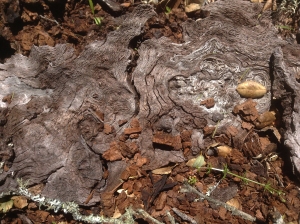
I spent the first day of summer on the mountain. I had planned to go up there by bus, as I generally do, but a good friend offered me a ride, and so the trip began with us in a grove of huge firs on the edge of the continent.
Being carless can open up possibilities that aren’t available if all you have to do is walk out the door and turn a key to get somewhere. A shared experience can be, like yesterday, deeper and more satisfying than being up there alone. That particular grove was full of ghosts last time I went there by myself. It was nothing more than the passage of time. The people who first took me there, in the morning of my life, are both gone. So many other friends who shared the place with me are scattered, gone or moved elsewhere. There are so many memories, mostly sweet, associated with the place and those moments in time. How could I not miss them? My partner and I were wed there. So were some of our circle. The only cure seems to be bringing others there, and making more memories.
The grove has changed over the years. Some of the trees are gone, others are growing, not in their place, but as a younger part of the grove. I remember the aftermath of a fire that wiped out a new stand of saplings. It taught me something about the role of fire in this landscape, for the following year the blackened, bare ground was transformed and the grove was new and fairy-beautiful. The thickets that had been taking over the edges were gone, and the green had returned, delicate and more varied than before. The saplings returned too, in time, and now they are taller than I am. Going there with others is similar to the greening after fire. I may have gone alone for a bit, but others use the space as well. After all, it is only my circle of friends who had their time and are now gone. We found the remains of flowers near the altar stone on this day before Beltane. The circle of stones around it was scattered and I did not put it right. Maybe next time, or maybe that is yet another change that has come. That circle was not there when I first came there, after all.
My camp was minimal, but comfortable. Pantoll is first-come, first-served, and since my days off are Sunday and Monday, I usually have the campground largely to myself. If you come without a car, there’s a hike and bike spot that is considerably cheaper than the rest of the sites, but I chose to take a site by myself at the top of the hill instead, a place where I could see the sunrise and be away from the noise of the road. I had a new tent and camping stove to try out and wanted to see how much it would add to my load. The bus stops at the ranger station, so it is possible to camp by bus with more than you might want to carry long distances. The camp has lockable food boxes, and I brought a lock with me, so I dropped my gear, pitched the tent and was off to enjoy the last day of Spring.

From Pantoll there are many paths to explore. I chose the Old Mine Trail, which is steep, but beautiful. There are plenty of places on the way up that will tempt you to linger, and it’s only a mile and a half to the top of the hill. All those places were full on this day–the entire mountain was full of people–but they were all there to enjoy this day between Spring and Summer—and they were outside. I hiked up slowly, the peace of the mountain settling around me. It’s changing again. So many oaks are dying, sudden for them, but years of human time encompassed in their passing.
Sudden Oak Death is endemic now. The trees that have it can’t be removed, doing so would only spread it faster. I can see the mountain adapting. So many places that were shady and green are now bared to the sun. Firs and laurels are moving into the light left, and like any dying thing, portions of the process of the oaks being reclaimed by the earth are not pretty, but there is such beauty in others.
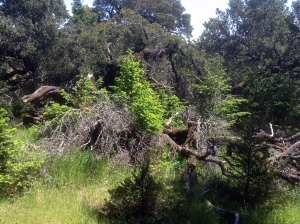
Once their tangle of twigs and branches is cleared, the fallen limbs fall apart in rivers of rich brown. Their silver branches contrast with the green around them, particularly in this year of abundant water. The new growth on the living trees is so pale it approaches chartreuse, and so luxuriant this year that whole young firs shine that color. The laurels and firs will have their time now, for the rest of my short human life I’ll watch the oaks decline, but they too will adapt. The ones who learn to survive will have a place in this woodland and we will learn from them in our turn. For now, the dead and dying oaks stand like ancient statuary, shorn of limbs, shooting out new growth for as long as they can. Their trunks are marked by their disease, myriad patterns and so many shades of brown all the way to the silver that surrounds them in their dead fallen branches.
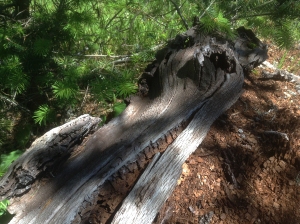
I sat with that grove of oaks for a while. I was sorry I hadn’t seen it in its green coolness, but on a day like today, I was venturing farther off to the sides of the trail for rest. I could see what it had been, and I’ll have a chance to see the beginnings of what it will become. By the time I got up to Rock Springs the parking lot was so full people were pulling to the sides of the road, using any turnout they could find. I find that being without a car limits me a bit in what green places I can get to, but it also allows me to get to know the places I do go in a deeper way. A place like the mountain has so many layers and so much beauty that I am still discovering places I’ve never seen after years of exploring.
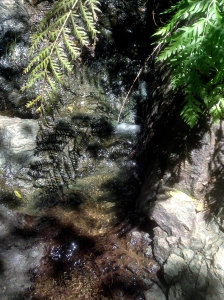
There was so much water! The whole mountain was singing the song of it. I could hear Rock Springs before I got there and filling my bottles took seconds. I drank deeply of the cold, clear water in a way I haven’t in a long time.
I came back to a nearly empty campsite, wanting a cup of tea. The ranger at the window when I’d checked in couldn’t sell me kindling for my camp stove, only a bundle of wood, but when I came back there was a plastic mesh bag with kindling in it lying on the stump at my site. At a campsite, you really do subsist on the kindness of rangers… It turned out to be more than enough to boil a pot of water and I found out that while the new biolite stove (URL) is indeed efficient, and the perfect toy for a firebug like me, it is also voracious. It turns little bits of wood into power, heat, and light, but you have to be there to feed it. It seems a fair trade to me and I was happy to be able to top up the charge on my phone. It was actually nothing short of magical to know that here is a tool that feeds off of what is abundant in any forest–small sticks, and with nothing more than a steady supply of that I can cook without damaging the ground and keep my electronics topped up.

I woke up as the sun was coming up. I’d had a fire as well, since I had the wood and who doesn’t like a fire when camping? I fired up the stove again and made a cup of tea, then went walking on the trail to Stinson Beach. I wanted to see the wildflowers and walk in the early morning. When I got out there I wished I’d taken the time to pack up, because I’d have been free to walk all the way to Stinson Beach. Another nice thing about going without a car is not having to return to where you’re parked. It’s a different kind of freedom. I can’t stop at every place that looks interesting by the side of the road, but neither am I tied to the road. The trail to Stinson Beach is only 4 miles, but by the time I got back to camp and packed up, there wasn’t time to walk the whole way by the time the bus left.
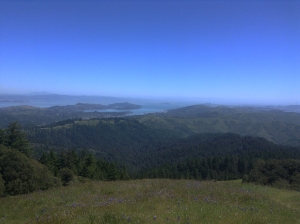
There wasn’t enough time by any measure. I only had a day and a night, and I knew I’d only get a taste of what I was after. A car wouldn’t have made much difference and I wouldn’t have been able to spend the whole time on the bus down the mountain looking at the scenery if I’d driven. The trip would have had a different quality and I would actually have seen a lot less than I did. Walking every day has slowed me down in ways I never expected. The journey is every bit as important than the destination, and I’m free to spend that time in conversation with the landscape.
The trees and the rocks tell stories, and not all of them can be photographed. In a wooded section of trail, for instance, an oak had begun to fall. A crotch in a limb broke its fall against a fir. The oak was sick, the two ends of the limb were ravaged by Sudden Oak Death and reached out in something that looked like terror–or was that just a trick of perspective? It had hit the fir many years ago, hard, because the trunk was knocked well off center, but the fir had had time to grow upward again in a graceful arc. Both trees were still alive, and the drama beside the trail will likely be playing out for many years to come, barring further catastrophe.

Farther along is a laurel that lost the battle with wind and torrential rain. It lies downhill, roots like a wall next to the trail. The crater that they occupied has now become the trail and there’s a rock there that was the perfect place to sit and look at the parts once firmly in the soil. I was sitting where the tree had once stood, looking at the stones still wrapped in roots, and each other.
In a forest that has been allowed to have these conversations with itself there is much to be learned. Root and branch and rock intertwine and shape each other. Straight, salable timber is nowhere near as interesting or as alive as a forest that has had time to get to know itself and has many different species living and growing together. The meadows, largely bare of trees, are full of flowers now and the dark green and the light show us where the water is. It is early summer now, and every flower and green leaf is singing life with all it has in it. Very soon, now that the rains have gone, the green will slowly fade to gold. The song of bees will turn to grasshoppers and the high song of Summer with its one clear, clean note. If I go there then the days will be hot and dusty, and just as I smell of oak right now, then I will smell of Lugh as I walk the trails. I’ll be doubly grateful for the spring then.

If you want to camp on Mt. Tam, directions and total trip time from your location are available on 511.org. Just search for directions to Pantoll Campground. You can get a number of buses out of San Francisco near Civic Center that cross the 61 South Route.
